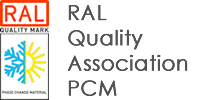Phase Change Materials have been used successfully for storing energy and stabilising tem-perature in numerous applications for decades. The ever increasing commercial importance of the technology triggered the need for reliable quality assurance and its independent certification. In 2004, several internationally active companies founded the Quality Association PCM with the objective to develop minimum performance requirements and suitable procedures for quality assurance. In 2006, RAL, the German Institute for Quality Assurance and Certification, accepted the Quality and Testing Specifications for PCM (RAL-GZ 896) and allowed to award high quality products with the RAL Quality Mark Phase Change Materials. The Quality and Testing Specifications have been revised and adapted to the state of the art at regular intervals ever since.
Vision & Mission
The Quality Association is active on an international level with member companies located in Germany, India, the Netherlands, the United Kingdom and the USA. Continuously developing the quality requirements, monitoring their compliance and awarding products with the RAL Quality Mark PCM are still the key activities. But it is getting increasingly important to educate political decision makers as well as planners about the potentials of the technology, particularly for the applications in buildings and energy storages. Due to their characteristics, PCM are an excellent solution to reliably and economically achieve the European Union´s ambitious goals with respect to energy saving, avoiding greenhouse gas emission and in-creasing the share of renewable energy.
The Quality Association is in contact with all stakeholders and makes sure that the PCM manufacturers´ and users´ interests are heard and understood. The quality assurance system and awarding the RAL Quality Mark are applied to promote and increase the use of high-quality PCM with long durability.
The RAL Quality Mark PCM – reliable performance, time after time
The RAL Quality Mark PCM is reserved for products which continuously comply with the requirements re. the following points:
• stored heat
The stored heat is the amount of energy a PCM can absorb and release again – the more, the better.
• phase transition temperature
Defines the temperature range in which the absorption and release of energy takes place. It should be as narrow and constant as possible.
• thermal condudctivity
The thermal conductivity should be as high as possible to enable a quick and complete transfer of energy.
• stability
There should not be any noticeable losses of performance for an operating life as long as possible. As an example, the PCM in construction materials that are included into the building structure should still perform perfectly after 30 years.
In order to not only confirm compliance once but continuously, the Quality Association devel-oped a system with in-house monitoring and external monitoring. Users of the RAL Quality Mark are obliged to implement an in-house monitoring system for checking the quality requirements continuously. After an independent external monitoring institute checked the in-house monitoring system and confirmed the compliance by means of a product lab test, the Quality Association awards the Quality Mark. Repeat inspections at regular intervals ensure continuous compliance.
